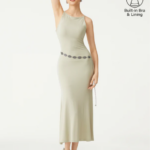While change is inevitable, we never expected to witness it in the fashion industry. But, it is now a reality, happening day in and day out with consumers being the driving force. Whether it is the millennials or Gen Z, they are all aligning their buying decisions with values like environmental and social responsibility.
Currently, over 70% of Millennials are choosing to pay more for sustainable products. This has been an important shift for the luxury fashion industry where sustainability is no longer a niche but a defining factor.
Yet, in this revolution, against all odds, some fashion brands are showing that ethical behavior does not necessarily mean abandoning quality, craftsmanship, and timeless design that define luxury. What is their secret? Or even better, why are consumers moving away from non-sustainable fashion and why do brands need to adapt?
Why consumers are saying no to unsustainable fashion?
Consumers are now aware of how much damage the fashion business causes to the environment (which accounts for 10% of all global carbon emissions as well as 20% of wastewater). For many customers, this environmental cost is a stiff price that cannot be paid in the near future. The only best solution is now for them to minimize further damage.
On another note, consumers know more about ethical practices in the fashion industry. Thanks to social media and documentaries, the spotlight is now on issues like unfair labor practices and poor working conditions in garment factories. At this time, they are only seeking out brands that prioritize ethical sourcing and production.
Why sustainable practices are essential for fashion brands?
Luxury brands must adapt to an evolving consumer landscape. Overlooking sustainability can have far-reaching implications, including:
- Loss of market share: Brands that do not change their practices risk losing customers to more eco-conscious competitors.
- Damage to brand reputation: People are becoming increasingly outspoken about concerns over sustainability hence, unsustainable companies may suffer serious reputational harm.
- Increased regulation: Governments worldwide are putting in place stringent regulations when it comes to environmental protection and ethical labor conduct. Failing to adhere to them can lead to significant financial losses and even lawsuits.
Embracing sustainable materials
Luxury brands have a responsibility to adapt to this evolving consumer landscape. Ignoring sustainability can have significant consequences, including:
Eco-friendly And Recycled Options
Fashion companies are moving from conventional materials with high environmental impact towards greener substitutes. Organic cotton, recycled polyester, or regenerated fibers like Econyl made from ocean waste belong here.
Stella McCartney, a pioneer of sustainable luxury, has used recycled cashmere and regenerated nylon in its collection to show that luxury might be attained without harming the environment. Fendi on the other hand is making products out of wool mohair silk and animal leather, which are a bit sustainable, unlike other materials.
Some are also investing in innovations and start-up collaborations to foster innovative, sustainable materials. A case in point is Gucci’s collaboration with a firm that produces Mylo, an alternative leather product made from mushroom roots.
Extending Product Lifespan And Embracing Circularity
Circular Economy Principles: The focus is now shifting to designing products for longer life spans, reparability as well as recyclability. This is consistent with circular economic principles which aim at reducing waste to the minimum and making resource usage most efficient.
Patagonia, renowned for its outdoor clothes, has a “Worn Wear” program where customers can repair or recycle their worn garments thereby increasing the lifespan of their products and reducing their environmental impact.
Resale And Rental Services
The advent of luxury resale platforms such as The RealReal together with fashion rental services like Rent The Runway means that there are ways of accessing second-hand luxury goods without new production’s environmental consequences.
It responds to growing consumer demand for conscious consumption and extends the lifetime of luxury items. For instance, Burberry partnered with The RealReal for a resale pilot program, which is an example of how traditional brands can adapt to changing consumer needs.
Ethical Sourcing And Supply Chain Transparency:
Responsible Sourcing: Ensuring that ethical labor practices and sustainable manufacturing methods are maintained throughout the entire supply chain. Kering, a luxury group that owns brands like Gucci and Saint Laurent has implemented a comprehensive sustainability initiative that involves responsible sourcing as well as ensuring fair treatment of workers and reducing environmental impacts in its supply chain.
Brands are increasingly releasing information about their sourcing practices and manufacturing locations so that consumers can make informed decisions.
Everlane thrives on transparency; therefore clients can trace their clothes journey online giving valuable insights into how social or even environmental repercussions of the production process were made.
Conclusion
Sustainable fashion has the best potential to impact positively on the environment and society the most. It’s expected to contribute to a cleaner and more just world. Most critically, participation in the sustainability agenda is already a trigger to innovation, such as new sustainable materials and production methods, though we are yet to see more.
In short, sustainability is a shortcut to peace of mind both for the human race and mother nature. And with the current threats to mother nature, all there is, as Stella McCartney put it well, “The future of the fashion-world is definitely green and circular.”








